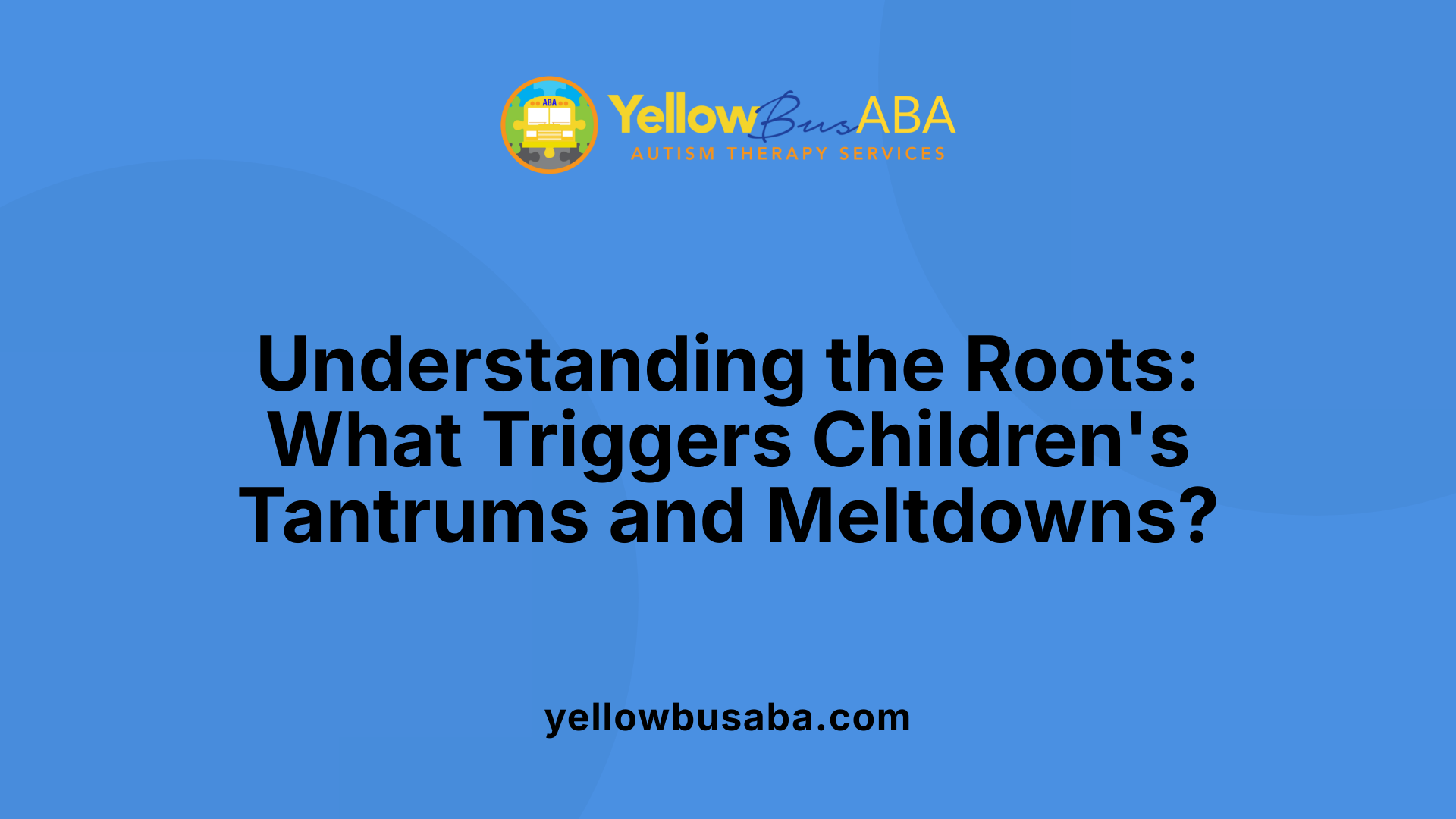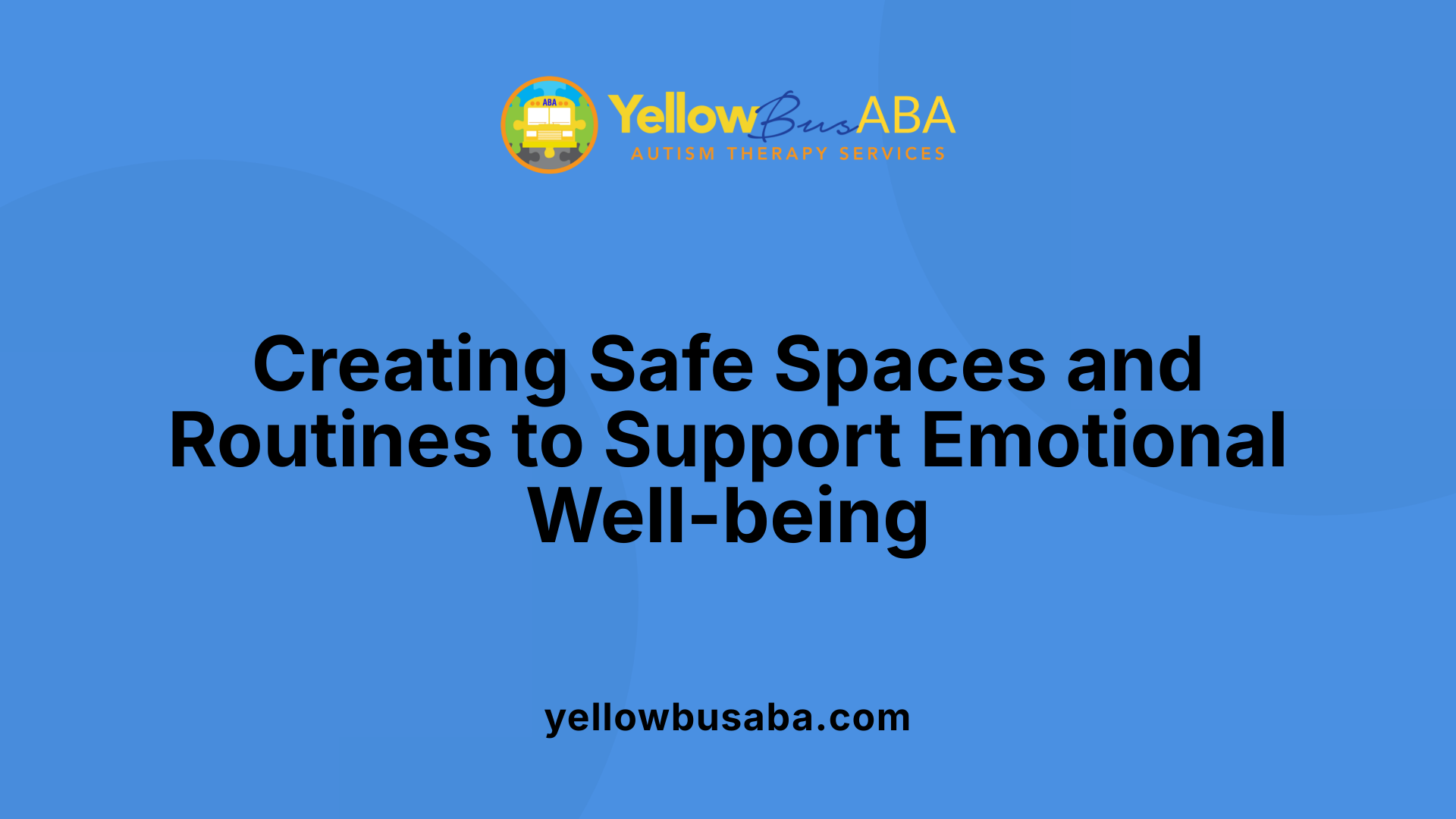Understanding and Addressing the Roots of Tantrums and Meltdowns
Temper tantrums and meltdowns are common challenges faced by parents of young children. While tantrums are typical expressions of frustration or anger, meltdowns, often more intense, result from sensory overload or emotional distress. Recognizing the underlying causes and triggers is vital for effective management. Parent training programs offer valuable tools and strategies to help caregivers support their child's emotional development, reduce problematic behaviors, and foster healthier parent-child relationships.
Identifying Triggers and Underlying Causes

What are the causes and triggers of tantrums and meltdowns in children?
Tantrums and meltdowns are common emotional reactions that children display when they feel upset, overwhelmed, or when they struggle to communicate their needs effectively. Understanding what causes these behaviors is essential for caregivers aiming to manage and prevent them.
The primary triggers for tantrums include basic needs such as hunger and tiredness. When children are hungry or fatigued, their ability to regulate emotions diminishes, often resulting in outbursts. Overstimulation from loud noises, bright lights, or busy environments can also overwhelm a child's sensory system, leading to tantrums, especially in children with sensory processing differences, autism spectrum disorder, or ADHD.
Transitions between activities or routines frequently serve as triggers. When children are asked to shift from one task to another—like moving from playtime to dinner—they may resist, causing frustration and tantrums. Additionally, when children desire independence and are unable to accomplish certain tasks, feelings of frustration can escalate.
Sensory overload is a particularly significant cause of meltdowns, which tend to be more intense and involuntary. Children with sensory sensitivities—common in neurodevelopmental conditions—are especially susceptible. They might show early signs like repetitive behaviors, increased stimming, or physical cues such as pacing when overwhelmed.
Other environmental factors such as chaos, bright lights, loud sounds, or unpredictable changes can heighten emotional responses. For some children, even minor disruptions in routine or environment can trigger significant reactions.
Developmental factors also influence these behaviors. Young children, especially toddlers, are still developing their brain regions responsible for emotional regulation, impulse control, and vocabulary. During this period, they experience intense emotions but lack the means to manage them effectively, leading to tantrums.
In summary, triggers encompass biological needs, sensory overload, environmental stimuli, transitional challenges, and developmental immaturity. Recognizing these factors allows caregivers to create safer, more predictable environments and implement strategies that reduce the likelihood of emotional outbursts.
The Role of Developmental Stages and Emotional Maturity

What developmental factors influence children's tantrums and how can parents address them?
Children's tantrums are often a reflection of their ongoing developmental journey, especially when it comes to emotional regulation. Understanding these developmental factors can help parents adopt more empathetic and effective strategies to manage and reduce tantrums.
One fundamental aspect is the maturity of the brain's emotional centers, particularly the prefrontal cortex. This region, responsible for impulse control, decision-making, and emotional regulation, continues to develop throughout childhood. In young children, especially toddlers, this area is still under construction, making it challenging for them to manage strong emotions such as anger, frustration, or disappointment.
As a result, children often express these overwhelming feelings through temper tantrums, which serve as an early form of emotional release. Recognizing that these behaviors are tied to brain development encourages parents to respond with patience and support rather than punishment.
In addition to neural development, children with language delays or sensory sensitivities often face extra hurdles. When children cannot easily articulate their feelings or struggle to process sensory input, they may become overwhelmed, leading to more frequent or intense tantrums.
Parents can support their child's developmental needs by creating a predictable environment filled with routines and routines that foster emotional security. Regular schedules for meals, naps, and activities help children feel safe and reduce anxiety during transitions, which are common triggers for tantrums.
Teaching children emotional vocabulary and coping skills tailored to their developmental level is also crucial. Using visual aids like feelings charts, practicing deep breathing, and role-playing social scenarios can help children learn to express emotions calmly.
Furthermore, addressing sensory sensitivities involves establishing sensory-friendly environments—such as quiet, dimly lit rooms, and providing sensory breaks or fidget tools—that can prevent overload. These accommodations help children manage their sensory inputs and reduce instances of emotional overwhelm.
In summary, children's tantrums stem largely from their developmental stage, brain immaturity, and sensory processing challenges. By providing supportive routines, tailored emotional learning, and sensory accommodations, parents can foster healthier emotional regulation and reduce the frequency and severity of tantrums. This holistic approach acknowledges that tantrums are part of normal growth, and guiding children through this phase with understanding promotes resilience and emotional maturity.
Effective Strategies for Managing Tantrums and Meltdowns

What are effective techniques for managing and reducing temper tantrums in children?
Managing temper tantrums effectively involves a combination of calmness, patience, and strategic responses. When a child begins to tantrum, staying composed and modeling calm behavior sets a powerful example. It helps the child feel safe and understood, which can prevent the situation from escalating.
Using distraction techniques can redirect a child's attention away from the source of distress. For example, singing a song, offering a favorite toy, or engaging in a quick game can shift focus. Positive reinforcement also plays a crucial role; praising a child for calming down or expressing their feelings appropriately encourages repeated positive behaviors.
Providing choices gives children a sense of control and reduces feelings of frustration. For example, “Would you like to put on your shoes first or your coat?” helps them feel empowered, decreasing the likelihood of a tantrum.
Creating and maintaining structured routines helps preemptively reduce tantrum triggers. Consistent schedules for meals, naps, and transitions provide predictability, which is comforting for children. Setting clear boundaries about acceptable behavior and reinforcing rules consistently establish a safe environment.
Meeting basic needs like hunger, tiredness, and overstimulation is essential. Ensuring children are well-fed, rested, and not overwhelmed can significantly decrease tantrum frequency.
Validating children’s emotions by acknowledging their feelings helps them develop emotional intelligence. Using phrases like, “I see you're upset because you want to stay longer,” can validate their experience while guiding them towards appropriate responses.
In episodes where a tantrum becomes intense, ignoring non-dangerous outbursts or redirecting attention can be effective. Safe spaces designated for calming down or simple timeouts give children the chance to self-regulate.
Persistent tantrums may require professional support. Behavioral specialists can offer tailored strategies for specific children, especially those with underlying conditions like ADHD or learning differences.
Overall, employing a calm, consistent approach, combined with proactive routines and emotional validation, helps children learn to manage their emotions and reduces the frequency and intensity of tantrums.
Use of distraction, validation, and positive reinforcement
Distraction works by redirecting a child's focus from their distress to something engaging or soothing. Validation involves actively listening to and acknowledging the child's feelings, which fosters emotional understanding and trust. Positive reinforcement, such as praise or small rewards, encourages children to repeat desirable behaviors, including calm responses and expressing needs verbally.
Creating structured routines and clear boundaries
Predictable routines decrease uncertainty and anxiety, reducing triggers for tantrums. Clear boundaries about what is acceptable help children understand expectations, preventing confusion and frustration. Consistency from caregivers reinforces trust and stability.
Using calm responses and safe spaces during episodes
Responding with calmness during a tantrum can help de-escalate the situation. Offering a designated calm space gives children a quiet environment to regain self-control. When necessary, safe and gentle timeouts allow children to cool down and reflect, supporting their emotional regulation skills.
| Approach | Description | Benefits |
|---|---|---|
| Calm responses | Maintaining a gentle tone and composed demeanor | Decreases escalation, models emotional regulation |
| Distraction | Redirecting attention to a different activity | Prevents tantrum escalation |
| Validation | Acknowledging children’s feelings | Builds trust and emotional awareness |
| Structured routines | Consistent schedules and expectations | Reduces triggers, increases security |
| Safe spaces | Designated calm areas | Facilitates self-regulation |
Employing these strategies in combination creates a supportive environment that fosters emotional growth and reduces problematic behaviors. Tailoring responses to individual needs and seeking professional help when necessary further enhance outcomes.
Parent Training Programs: Building Skills and Confidence

How can parent training programs benefit children's behavioral management?
Parent training programs are valuable resources that equip parents with practical strategies and tools to handle challenging behaviors effectively. These programs often involve coaching from child development specialists or psychologists, providing tailored guidance on behavioral management techniques that can be applied consistently across various settings.
One of the main benefits is improved behavior in children, as parents learn to reinforce positive actions and establish clear boundaries. By actively participating in these programs, parents become more confident in their ability to support their child's emotional and social development.
Additionally, parent training helps reduce stress for families by offering structured approaches to manage tantrums, meltdowns, and other problematic behaviors. When parents understand the underlying causes of their child's behaviors—such as difficulty with emotional regulation, sensory sensitivities, or communication challenges—they can respond more empathetically and appropriately.
These programs also foster stronger parent-child relationships, as they promote consistent and supportive responses rather than reactive or harsh discipline. For children with neurodevelopmental conditions like autism spectrum disorder (ASD) or attention deficit hyperactivity disorder (ADHD), structured behavioral plans tailored to their specific needs can significantly improve their functioning and emotional resilience.
In summary, parent training creates a supportive environment where children can develop better self-regulation and social skills. It empowers caregivers to be active partners in their child's growth, leading to positive behavioral changes and a more harmonious family life.
How does training improve consistency and skill support?
Consistent responses are crucial in behavioral management, as they help children learn expectations and develop trust. Parent training emphasizes the importance of establishing routines, setting clear rules, and applying strategies uniformly. This consistency reduces confusion and helps children understand the boundaries within which they can express themselves.
Training also teaches parents how to model emotional regulation and self-control, which children often imitate. For example, staying calm during a tantrum demonstrates healthy coping skills, encouraging children to do the same.
Moreover, parents are guided on how to reinforce positive behaviors through praise and rewards, which motivate children to repeat desirable actions. Techniques such as providing immediate feedback and using visual supports can make the learning process clearer for both children and parents.
By fostering an environment of predictability and reinforcement, parent training supports the child's emotional and social learning. This environment helps children better manage frustrations, resist impulsive reactions, and develop resilience over time.
Supporting children with neurodevelopmental conditions
Children with conditions like ASD, SPD (sensory processing disorder), or ADHD often face additional challenges with self-regulation, communication, and sensory sensitivities. Parent training programs are specially designed to address these unique needs.
For example, parents learn to create sensory-friendly environments and employ sensory breaks, which help prevent meltdowns caused by overstimulation. They are also taught to recognize early warning signs of distress, such as increased stimming behaviors or physical cues, allowing for timely intervention.
Communication barriers are common in neurodiverse children; training includes strategies such as visual supports, communication aids, and alternative methods to express needs, reducing frustration and behavior outbursts.
Furthermore, behavioral plans in these programs often incorporate individualized goals, focusing on skills like transitioning between activities, managing sensory overload, and practicing social interactions.
By developing tailored strategies, parent training empowers caregivers to support their children's unique developmental trajectories, promoting greater independence and emotional stability.
Practical strategies from parent training
| Strategy | Purpose | Example | Benefit |
|---|---|---|---|
| Establishing routines | Creates predictability, reduces anxiety | Consistent meal, nap, and bedtime schedules | Helps children anticipate and prepare for transitions |
| Using visual supports | Enhances communication, especially for non-verbal children | Visual schedules or emotion charts | Decreases frustration and improves understanding |
| Reinforcing positive behavior | Encourages repetition of desirable actions | Praising sharing or cooperation | Builds self-esteem and promotes good habits |
| Self-regulation modeling | Teaches children emotional management | Calmly responding during tantrums | Fosters emotional resilience |
| Sensory management strategies | Prevents sensory overload and meltdowns | Offering sensory breaks or using noise-canceling headphones | Supports sensory needs and reduces emotional overwhelm |
| Clear and consistent boundaries | Provides structure, reduces behavioral ambiguity | Setting firm rules about screen time | Promotes discipline and emotional regulation |
Additional support through parent training
Parent training programs often include modules on stress management for parents, techniques for building trust, and methods to encourage emotional literacy. These programs are supported by evidence showing their effectiveness in reducing disruptive behaviors and strengthening family bonds.
Some programs incorporate community support groups, allowing parents to share experiences and strategies, fostering a network of mutual encouragement.
Overall, investing in parent training enhances the caregiving environment, equipping parents with skills that lead to immediate improvements and long-term benefits for children's behavioral and emotional health.
Teaching Emotional Regulation Skills to Children
What techniques can parents use to teach children self-regulation skills to prevent tantrums and meltdowns?
Helping children develop emotional regulation is essential in reducing tantrums and meltdowns. Parents can adopt several effective strategies rooted in understanding and supporting their child's emotional needs.
One foundational technique is modeling calm behavior. When parents maintain composure during stressful situations, children learn by observing that emotional control is possible even in challenging moments. For example, taking deep breaths or calmly discussing feelings sets a positive example.
Another important method is emotion-labeling. Encouraging children to identify and articulate their feelings helps them build emotional vocabulary. Simple phrases like “You seem angry” or “It’s okay to feel upset” validate their emotions and provide language to express themselves better.
Use of visual supports and social stories further enhances understanding. Visual aids, such as emotion charts or feelings wheels, give children concrete cues to recognize their emotions. Social stories can depict scenarios that teach appropriate responses, helping children prepare for upcoming activities or transitions.
Teaching self-soothing techniques like breathing exercises, mindfulness, or progressive muscle relaxation can empower children to manage strong feelings proactively. Breaking complex or difficult tasks into smaller steps supports emotional mastery by making challenges more manageable.
Gradually increasing independence in tasks like brushing teeth or transitioning from play to rest builds confidence and self-control. Offering choices—such as selecting a toy or activity—also fosters a sense of control, reducing frustration that can lead to tantrums.
Consistent reinforcement is vital. Praising children for using words to express feelings or for staying calm during difficult moments encourages continued use of these skills.
Lastly, open discussions about feelings before they escalate help children become more aware of their emotions. Creating a routine where children feel safe sharing their frustrations and successes supports emotional development and promotes positive behavioral patterns.
Implementing these techniques inside a structured environment lays a solid foundation for children to manage their emotions independently, leading to fewer tantrums and improved overall emotional resilience.
Strategies for teaching self-awareness and coping skills
| Strategy | Description | Benefits |
|---|---|---|
| Modeling calm behavior | Parents demonstrate calm reactions in stressful moments | Teaches children how to respond similarly |
| Emotion-labeling | Using words or visuals to identify feelings | Builds emotional vocabulary and awareness |
| Visual supports | Feelings charts, emotion wheels, social stories | Provides concrete cues for understanding emotions |
| Self-soothing tools | Breathing exercises, sensory toys, mindfulness activities | Empowers children to manage emotions independently |
| Breaking tasks into smaller steps | Gradually increasing independence in activities | Reduces frustration, enhances emotional control |
| Reinforcement and praise | Recognizing and rewarding positive emotional expression | Encourages healthy coping behaviors |
| Routine discussions | Talking about feelings proactively | Prevents escalation, promotes emotional literacy |
Use of visual supports and social stories
Visual supports play a crucial role in helping children understand and express their emotions. Emotion charts with color-coded faces or feelings wheels visually depict a range of emotions, allowing children to point to or select how they’re feeling.
Social stories depict specific situations and suggest appropriate responses, such as what to do when feeling overwhelmed or how to ask for a break. They prepare children for transitions and reduce anxiety.
Both tools foster emotional self-awareness and provide accessible language that supports children with communication challenges, including those with sensory processing differences or language delays.
Incorporating visual supports and social stories into daily routines creates a structured, predictable environment. This stability helps children feel secure and better equipped to manage their emotions, significantly decreasing the likelihood of tantrums or meltdowns.
By consistently using these strategies, parents build their child's self-awareness, resilience, and ability to cope with frustration or sensory overloads effectively.
Creating Supportive Environments and Routines

How should parents handle children’s meltdowns, including those with autism?
Supporting children during meltdowns requires a calm, empathetic approach tailored to their specific needs. Parents should prioritize safety, ensuring the child is in a secure environment free from danger. Staying calm during the episode helps the child learn emotional regulation through observing a composed caregiver.
Recognizing early warning signs such as repeating phrases, pacing, or heightened physical activity can help parents intervene early before the meltdown escalates. Providing a quiet, sensory-friendly space, often called a 'calm corner,' allows the child a safe place to self-soothe and regain control.
Avoiding known triggers like loud noises, bright lights, or abrupt changes by establishing predictable routines is crucial. Visual schedules support children, especially those with autism, by offering visual cues of upcoming activities, reducing anxiety and uncertainty.
Incorporating sensory tools such as noise-canceling headphones, fidget toys, or calming lighting can mitigate sensory overload. Teaching deep breathing or other calming strategies during regular times builds a repertoire of skills the child can use independently.
During a meltdown, guiding the child to the sensory-friendly space, providing comfort items, and giving them time to cool down can prevent the situation from worsening. Post-meltdown, engaging in gentle discussions about feelings, and teaching coping skills suited to the child's age and sensory needs, reinforce emotional self-regulation.
Overall, a consistent routine, sensory accommodations, and structured support help children manage overwhelming emotions better, reducing the frequency and intensity of meltdowns.
Reinforcing Positive Behavior and Building Trust

What techniques for reducing tantrums and promoting positive behaviors are effective?
Implementing positive reinforcement and praise are proven methods to encourage children to develop good behavioral habits. When a child exhibits a desirable action, such as sharing toys, taking deep breaths during frustration, or following routines, parents and caregivers can respond by praising or rewarding these behaviors. This approach not only motivates children to repeat the positive actions but also helps them associate good behavior with feelings of achievement and acceptance.
A practical technique commonly used is the 'catch them being good' strategy. Instead of focusing on misbehavior, this method emphasizes recognizing and complimenting specific positive behaviors. For example, saying, "I really liked how you asked for help politely," reinforces respectful communication. Over time, this recognition boosts children’s confidence and encourages them to regulate their emotions better, leading to fewer tantrums.
Creating a secure and trusting environment plays a critical role in reducing emotional outbursts. Consistent routines for meals, sleep, and activities provide predictability that children find comforting. When boundaries and expectations are clear, children know what to expect and feel safe, which diminishes anxiety and frustration.
Active listening and validating feelings are important tools in fostering trust. When children express their emotions—even if they’re negative—parents who listen attentively and acknowledge these feelings help children feel understood. Phrases like, "It’s okay to be upset; I see you’re angry because you can't have the toy right now," validate the child’s emotions and promote emotional regulation.
Furthermore, nurturing a close, affectionate relationship supports emotional safety. Building a bond based on trust and understanding motivates children to seek guidance and share their feelings openly. When children feel secure and supported, they are less likely to resort to outbursts to express unmet needs or overwhelming emotions.
In summary, effective strategies include positive reinforcement and praise, establishing routines, active listening, and fostering secure attachments. These approaches create an environment where children feel respected and safe, significantly reducing the frequency and intensity of tantrums and promoting healthier emotional development.
Summary and Long-Term Benefits of Parent Training
How do behavioral strategies from parent training improve communication and emotional understanding?
Behavioral strategies from parent training significantly enhance a child’s ability to communicate effectively and develop emotional understanding. These techniques teach children to articulate their feelings clearly, which is essential for emotional regulation.
Parents learn to use emotion-labeling, which involves helping children identify and name their feelings, such as saying, “You seem really angry right now.” This practice increases emotional awareness and vocabulary.
Active listening is another important skill taught in parent training. When parents attentively listen to their children, validate their feelings, and respond calmly, children learn that their emotions are acknowledged and understood. This strengthens trust and encourages open communication.
Modeling calm and controlled responses is crucial. When caregivers respond to children’s emotional outbursts with patience and composed behavior, children internalize these strategies. Over time, children imitate these calm responses, which helps them manage their own emotions more effectively.
Consistent routines and positive reinforcement contribute to a predictable environment that reduces anxiety and emotional outbursts. When children know what to expect and receive praise for appropriate behaviors, they feel secure and are more likely to use healthy coping mechanisms.
By combining these approaches, parent training creates a supportive setting where children can explore and understand their emotions gradually. This leads to improved emotional resilience, greater independence, and stronger social skills.
Overall, these strategies foster long-term benefits such as better impulse control, enhanced interpersonal skills, and improved relationships with peers and adults. The development of emotional intelligence sets a foundation for success in various areas of life, including academics, social interactions, and future emotional health.
Building emotional resilience over time
Emotional resilience is the capacity to handle stress and recover from setbacks. Parent training supports this by teaching children self-regulation techniques like deep breathing, mindfulness, and reflective self-awareness.
Practicing these skills consistently helps children develop the ability to manage frustration and adapt to changing circumstances. For children with neurodevelopmental conditions like ADHD or anxiety, targeted strategies can bolster their ability to self-regulate.
As children experience success with these techniques, their confidence grows. They become more adept at recognizing their emotions, expressing needs appropriately, and turning to coping skills during challenging moments.
Benefits of consistent routines and behavior management
Establishing stable routines, such as regular meal times, bedtimes, and daily activities, provides a sense of security. When routines are consistent, children know what to expect, which reduces anxiety and prevents tantrums.
Behavior management that combines clear boundaries with positive reinforcement encourages children to repeat desirable behaviors. Recognizing efforts and providing praise for calm, respectful interactions fosters a positive cycle of behavior.
Strong routines and consistent responses also help children learn responsibility and self-discipline, which are essential for academic success and social interactions.
Fostering independence and social skills
Parent training emphasizes giving children appropriate choices to promote autonomy within set boundaries. This fosters independence and decision-making skills.
Social skills are cultivated through role-playing, social activities, and teaching emotional vocabulary, helping children interpret social cues and respond appropriately.
When children can effectively communicate their needs and understand others’ feelings, they build healthier relationships. This social competence supports their overall emotional development and lays the groundwork for peer relationships and collaboration.
Long-term impact on children and family dynamics
In summary, behavioral strategies learned through parent training create an environment that nurtures emotional resilience, independence, and social aptitude. The long-term benefits include reduced behavioral issues, stronger parent-child relationships, and healthier social interactions.
Parents report greater confidence and lower stress levels as they apply these skills, leading to a more harmonious family life. As children grow, these foundational skills support their transition into adolescence and adulthood, promoting overall well-being and positive mental health.
| Aspect | Developmental Benefit | How Parent Training Contributes |
|---|---|---|
| Emotional resilience | Ability to cope with stress | Teaching coping skills, emotional labeling, modeling calm behavior |
| Routine stability | Reduces anxiety, tantrums | Establishing consistent routines, predictable environments |
| Independence | Self-confidence, decision-making | Offering choices, fostering autonomy |
| Social skills | Healthy peer relationships | Role-playing, social activities, emotional vocabulary |
| Long-term family health | Reduced conflict, greater connection | Behavior management, effective communication, emotional understanding |
Understanding the long-term effects of parent training underscores its value in fostering well-rounded, emotionally resilient children capable of positive social interactions and healthy relationships well into future years.
Empowering Parents, Enhancing Children's Emotional Lives
Parent training programs play a crucial role in equipping caregivers with scientifically backed techniques to manage tantrums and meltdowns effectively. By understanding triggers, fostering emotional regulation, and reinforcing positive behaviors, parents can create a supportive environment that promotes emotional resilience, independence, and better communication skills in children. The benefits extend beyond immediate behavior management, contributing to healthier parent-child relationships and long-term emotional well-being. Continuous learning, patience, and consistency are key to transforming challenging behaviors into opportunities for growth and connection, laying the foundation for children to navigate their emotions successfully now and in the future.
References
- How to Handle Tantrums and Meltdowns - Child Mind Institute
- Mastering Meltdowns: A Parent's Guide to Handling Tantrums
- Navigating Tantrums and Meltdowns: Strategies for Parents and ...
- Taming Temper Tantrums: Behavior Management for Toddlers
- How Parenting Classes Can Help You Manage Toddler Tantrums
- How Parent Training with a Child Psychologist Can Transform Your ...
- How to Handle Child Tantrums and Meltdowns - Anchor Light Therapy






